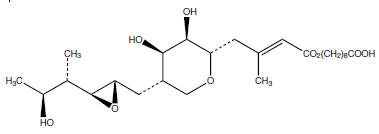Mupirocin Veterinary Ointment
Generic name: mupirocin ointment
Dosage form: FOR ANIMAL USE ONLY
On This Page
For dermatologic use on dogs
CAUTION
Federal law restricts this drug to use by or on the order of a licensed veterinarian.
Mupirocin Veterinary Ointment Description
Each gram of mupirocin ointment contains 20 mg of mupirocin in a bland, water-washable ointment base consisting of polyethylene glycol 400 and polyethylene glycol 3350 (polyethylene glycol ointment). Mupirocin is a naturally-occurring, broad-spectrum antibiotic. The chemical name is 9-4-[5S-(2S,3S-epoxy-5S-hydroxy-4S-methylhexyl)-3R,4R-dihydroxytetrahydropyran-2S-yl]-3-methylbut-2(E)-enoyloxy-nonanoic acid. The chemical structure is:

Mupirocin Veterinary Ointment - Clinical Pharmacology
Mupirocin is a chemical entity produced by fermentation of the organism Pseudomonas fluorescens. Mupirocin inhibits bacterial protein synthesis by reversibly and specifically binding to bacterial isoleucyl transfer-RNA synthetase. Due to this mode of action, mupirocin shows no cross resistance with chloramphenicol, erythromycin, gentamicin, lincomycin, neomycin, novobiocin, penicillin, streptomycin, and tetracycline. Mupirocin is an antimicrobial agent that inhibits the growth of gram-positive and gram-negative bacteria.
Bacteria susceptible to the action of mupirocin in vitro include the aerobic isolates of Staphylococcus aureus (including methicillin-resistant strains and β-lactamase-producing strains), Staphylococcus intermedius, Staphylococcus epidermidis, other coagulase positive or negative Staphylococci, α-hemolytic Streptococci, β group A Streptococci (including S. pyogenes), other β Streptococci (including S. agalactiae), group D Streptococci (including S. faecalis and S. faecium), group Viridans Streptococci, Streptococcus pneumoniae, Corynebacterium hofmanii, Bacillus subtilis, Escherichia coli, Klebsiella pneumoniae, Proteus mirabilis, Proteus vulgaris, Enterobacter cloacae, Enterobacter aerogenes, Citrobacter freundii, Hemophilus influenzae (including β-lactamase-producing strains), Neisseria gonorrheae (including β-lactamase-producing strains), Neisseria meningitidis, Branhamella catarrhalis and Pasteurella multocida, and the anaerobic isolates of Peptostreptococcus anaerobius, Clostridium difficile, and Clostridium sporogenes.
Clinica...



